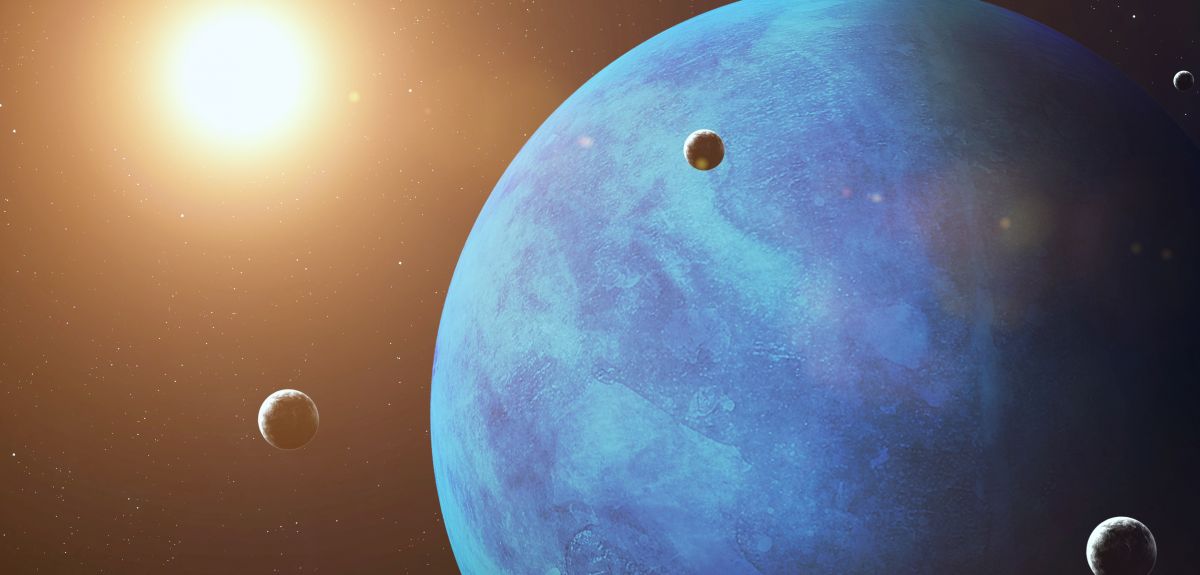
Image credit: Shutterstock
There's a funny atmosphere on Neptune…
It has been the farthest planet from the Sun since Pluto's 'relegation', but despite Neptune's remoteness in our solar system, it still holds plenty of interest for physicists – not least because of the unusual things going on in its atmosphere.
A new paper published in the journal Nature Communications by Dr Karen Aplin of Oxford University's Department of Physics attempts to get to the bottom of the 'wobbles' observed in Neptune's atmosphere over the past 40 years.
The study, written with Professor Giles Harrison of the University of Reading, evaluates two competing hypotheses for why we can see changes in the planet's brightness – a phenomenon essentially connected to its cloud cover. The results solve a long-standing conundrum in planetary science.
Dr Aplin says: 'Neptune's great distance from the Sun means that its atmosphere is very cold, but despite this it has some interesting weather, including clouds, winds, storms and perhaps lightning. It provides an entirely different environment to help us test our knowledge of atmospheres.
'Unlike Earth's atmosphere, which is mostly nitrogen, Neptune's atmosphere is mainly hydrogen and helium, with some methane. The methane absorbs much of the red light in the atmosphere, making the planet seem blue to us.
'Neptune’s atmosphere contains clouds made of a range of substances, such as ammonia and methane, whereas clouds on Earth are almost always made of water. Neptune's atmosphere is also a lot colder than ours – around -170C – because it receives 900 times less sunlight. Despite this, the Sun can still affect its clouds in subtle ways.'
Since the early 1970s, Neptune's brightness has been measured with great care by Dr Wes Lockwood of Lowell Observatory in Arizona. Because Neptune rotates around the Sun once every 165 years, each of its seasons is about 40 Earth years. Most of the ups and downs seen in Neptune's brightness since the 1970s are therefore due to its slowly changing seasons. However, even when the seasonal changes are accounted for, there are still some other small 'wobbles' in Neptune's clouds – and these are the subject of Dr Aplin's study.
Dr Aplin says: 'The "wobbles" in Neptune's cloudiness appeared to follow the Sun’s 11-year activity cycle, which could mean that they were influenced by small changes in sunlight. Another suggestion was that particles from outer space, called cosmic rays, which are also affected by the solar cycle, were changing the clouds. Using the different physics of the two mechanisms, we showed that the combined effect of the two "rival" hypotheses explained the changes in cloudiness more successfully than each would do individually.
'We also looked for a known marker of cosmic ray effects, a kind of fingerprint, in Neptune's cloud data. During the 1980s, when the Voyager 2 mission was nearing Neptune, we were able to compare both cosmic rays and clouds at Neptune and show that they had the same fingerprint. We were therefore able to confirm the effects of cosmic rays in planetary atmospheres.'
Another mission to Neptune would allow for even more scientific insight into this distant planet. But, with nothing currently planned, scientists will continue to rely on telescopic observations combined with simulation experiments of the type carried out in Dr Aplin's laboratory.